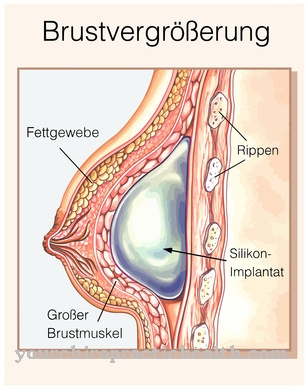Of the Kidney infarction is a vascular occlusion in the kidneys that affects the blood flow and oxygen supply to the kidney tissue and causes the tissue to die as a result. The most common causes of this ischemic phenomenon are thrombosis and embolism. Complete kidney infarctions can later force the patient to dialysis, while the kidneys often recover completely from partial infarctions.
What is a kidney attack?

© magicmine - stock.adobe.com
As Kidney infarction the doctor describes the destruction of kidney tissue as a result of an embolic vascular occlusion. The kidneys are traversed by many arteries and supplied with oxygen via this arterial system. If there is an occlusion in the arterial vascular system, the tissue is cut off from the blood flow and thus doomed to die in the long run.
This phenomenon is also known as ischemia, so that a kidney infarction is often referred to as an ischemic reaction. The doctor often speaks of an embolic kidney infarction. In this context, the embolism means an arterial occlusion caused by foreign or endogenous materials. The starting point of a kidney infarction is usually the kidney capsule with its blood-carrying structures.
Sometimes a kidney infarction also refers to a venous occlusion, which can result in a hemorrhagic, i.e. bleeding-related infarction of the kidneys and permanently dilate the kidneys. This is to be distinguished from anemic kidney infarction, which does not expand the organs, but rather deforms them through scar tissue with craters.
The doctor differentiates a kidney infarction in addition to the differentiation according to causes, especially in the type of occlusion. Complete occlusion corresponds to absolute ischemia and as a result causes the kidney tissue to die off completely. An incomplete occlusion in an arterial vessel only results in a local reduced blood flow.
causes
The blockage of a renal artery or vein can have various causes, but more than 90 percent of kidney infarctions are embolisms. An embolism can occur as a result of a blood clot that has washed in, but also fat or blistering in the blood are among the embolic causes.
In cancer patients, tumor tissue that has washed in can also trigger an embolism. Cholesterol embolisms, in turn, result from loosened plaques on an arterial wall, while septic embolisms result from bacterially infected embolisms. Most often, however, the cause of an embolic kidney infarction is a blood clot washed in from the aorta or the heart wall, where a thrombosis has previously occurred.
This phenomenon can also be related to arteriosclerosis or vasculitis. Hemorrhagic kidney infarcts, on the other hand, usually result from circulatory shock, whereby a thrombosis forms in the renal vein itself due to a slowdown in the blood flow. Connective tissue diseases, vascular diseases as well as heart diseases and vascular injuries are considered to be the most important risk factors for a kidney infarction.
Symptoms, ailments & signs
A typical symptom of kidney infarction is acute pain in the flank. Depending on the severity of the infarct, this pain can be accompanied by severe abdominal pain. Nausea, fever and vomiting are also symptomatic. An accompanying increase in leukocytes may be seen in the serum. Acute kidney failure can occur days after the kidney infarction, which often manifests itself as bleeding when urinating.
If arteriosclerotic material is responsible for the infarction in the case of an embolic cause, then this material can subsequently also be deposited in other organs or body parts.Therefore, symptoms of kidney infarction can also include visual field defects or inflammations in various localizations. Partial kidney infarcts in particular often remain completely symptom-free. Although functional impairments of the kidneys can occur even with partial infarctions, these impairments do not have to be immediately noticeable.
Diagnosis & course of disease
The anamnesis and palpation give the doctor first indications of a possible kidney infarction. The quality of the flank pain in combination with a vascular disease in the patient can, for example, already give him the idea of a kidney infarction. He often examines the serum, which may also show elevated creatine and an increase in leukocytes.
The doctor usually makes the definitive diagnosis of kidney infarction using angiography or computed tomography. In this imaging, the infarct usually shows a relatively typical picture, which also enables differentiation into partial or complete infarction. After the diagnosis has been made, the attending physician may order a sonographic examination of all arteries and veins, which may give indications of previous thromboses or show calcified vascular walls.
Heart examinations can also make sense to rule out heart function as the source of the kidney infarction. The course of the disease in kidney infarction always depends on how severe and how long the infarction actually was. For cholesterol-embolic kidney infarction, the prognosis is generally poor. In this case, in particular, the patient may need dialysis in the future. Partial kidney infarcts, on the other hand, often heal completely.
Complications
The course of a kidney infarction depends on the duration and extent of the undersupply of blood to the kidneys. In about 25 percent of the cases, the infarction proceeds without symptoms because only small areas of the kidney die. If necrosis of larger areas of the kidney occurs, acute kidney failure may also occur. The prognosis is particularly poor in the case of a so-called cholesterol embolism, which usually results in renal insufficiency requiring dialysis.
In the context of acute kidney failure, the end products of protein metabolism and all other urinary substances remain in the blood. In addition, the electrolyte balance gets completely mixed up. The same applies to the acid-base balance. Uremia, a life-threatening state of intoxication, can develop. Uremia characterizes the increased occurrence of urinary substances in the blood, which in Greek is also called "urine in the blood".
In addition to unbearable itching, there is nausea, vomiting and black blood in the stool as a result of stomach and intestinal inflammation. In addition, pulmonary edema, shortness of breath and cyanosis occur. Too high a level of urea in the blood can cause pathological changes in the brain and other neurological disorders.
The ability of the kidneys to regenerate after acute kidney failure as a result of a kidney infarction is good. Sometimes, however, as already mentioned, permanent kidney damage that requires dialysis occurs. In individual cases, fatal multiple organ failure can occur due to the secondary impairment of various organs.
When should you go to the doctor?
A kidney attack is always a reason to see a doctor as soon as possible. An emergency ward is preferable because a moderate to very severe infarct requires acute treatment. A complete kidney infarction can mean the end of the entire kidney, which makes seeing a doctor all the more urgent. However, partial occlusion of a blood vessel on or in the kidney can lead to severe necrosis after a while and permanently damage or kill the kidney.
If only one functioning kidney is left or both are affected, kidney failure will result if not timely action is taken. The problem in this context is that minor kidney infarctions are often symptom-free and therefore only cause hidden damage. Often only the long-term effects are noticed.
In the case of kidney infarction, the smallest signs of kidney damage can be used as an opportunity to see a doctor (or, if necessary, to a hospital). These include in particular acute and severe pain in the flanks and brownish or reddish discolored urine. The pain in particular must also be diagnosed because it indicates several ailments. For example, kidney stones, colic or inflammation can be detected in this way.
People who already have kidney problems, have a transplant or only have one (functioning) kidney should have any possible evidence of a heart attack checked.
Treatment & Therapy
Kidney attacks are usually treated conservatively. The administration of painkillers and the regulation of blood pressure are also part of this conservative therapy, as is systemic complete heparinization. The latter measure corresponds to the administration of an anticoagulant to dissolve any blood clots.
Depending on how severe the infarct was and how early the doctor was able to make the diagnosis, lysis therapy or emergency surgery may also be considered, which may still be able to resolve an existing embolus. Since operations for this purpose are associated with a high risk, they are used less often than lysis therapies.
In lysis therapy, the doctor inserts a catheter into the existing blood clot and releases enzymes such as urokinase to dissolve the clot. Dialysis can also be useful for acute kidney infarctions. This measure does not necessarily mean that the kidneys will not recover over time.
Outlook & forecast
The prognosis for a kidney infarction depends on the severity and duration of the decreased kidney blood flow. Complete recovery of the affected kidney is possible, as is complete kidney failure. If a kidney infarction is left untreated, it is fatal. The prognosis is particularly poor in the case of a kidney infarction in connection with a cholesterol embolism. The patients then usually need dialysis. However, even with temporary dialysis, the kidneys can recover.
A good prognosis depends on the rapid diagnosis and therapy of the kidney infarction. If the condition is treated at an early stage, for example when the typical flank pain occurs for the first time, the complete organ infarction can possibly be prevented. The prognosis for a kidney infarction is made by the specialist in internal medicine. Usually a nephrologist is the attending physician who, among other things, includes the symptoms and the severity of the kidney infarction to evaluate the course of the disease.
A kidney infarction with subsequent compulsory dialysis has a negative impact on life expectancy, as dialysis increases the risk of infection, among other things. If the outcome is positive, the life expectancy of the sick person is not necessarily restricted. The quality of life can be significantly reduced as a result of a damaged kidney.
prevention
To prevent kidney infarction, a change in lifestyle is useful. The focus of the preventive measures is on reducing the risk of arterial calcification. Quitting nicotine and eating a healthy diet are just as good preventive measures in this regard as abstaining from alcohol, weight loss and exercise.
Aftercare
Since a kidney infarction can have different consequences, dutiful follow-up care makes sense. Those affected can largely take this into their own hands by changing their habits and everyday life for the better. First and foremost is the strengthening and full recovery of the body.
This can be achieved with the help of various measures. In any case, an important aspect is a sufficient supply of oxygen and an appropriate amount of exercise that does not overwork the body. If possible, this should take place outdoors so that a healthy amount of fresh air can reach the body.
In addition, at least two liters of water should be drunk daily, which will stimulate the kidneys again. The consumption of harmful substances such as alcohol, drugs or nicotine should be avoided entirely. In addition, attention should be paid to a balanced, low-fat and all-round healthy diet. If necessary, overweight should be reduced in order to save the organism unnecessarily exhausting expenses.
Since both the physical and the psychological state play a role in a full recovery, attention must also be paid to mental strain and stress. In order to be able to effectively reduce such complaints and emerging stress, meditation, relaxation and regular rest breaks are of enormous importance.
You can do that yourself
Kidney infarction is symptom-free for a long time in many patients. Therefore, basic precautionary measures that strengthen the organism are advisable. A sufficient supply of oxygen is helpful. The activity of the heart muscle can be supported by regular exercise or staying outdoors. Physical overexertion or intensive effort should be avoided.
In addition, regular breaks should be taken so that the organism receives sufficient rest phases. The intake of harmful substances such as alcohol, nicotine or drugs must be completely avoided. For an optimal supply of the organism, a fluid intake of two liters per day is recommended. Fatty foods or the consumption of foods that are difficult to digest should be avoided. With a healthy and balanced diet, the body receives enough nutrients to stabilize the immune system and promote overall health.
Stress and hectic rush must also be reduced. Methods such as yoga, autogenic training or meditation can be used to reduce internal stress factors. The person affected has the opportunity to do a few exercise units every day and thus strengthen their inner strength. A positive outlook on life and individual measures to improve well-being are also helpful. Since kidney infarction can be fatal, a doctor should be consulted immediately in the event of symptoms or deterioration in health, despite all precautionary measures.



.jpg)


.jpg)




















